If you’re motorhoming in the Spring in the UK you’re probably going to get caught in the odd downpour of rain. Wet weather can make for some pretty muddy and testing conditions for your motorhome or campervan.
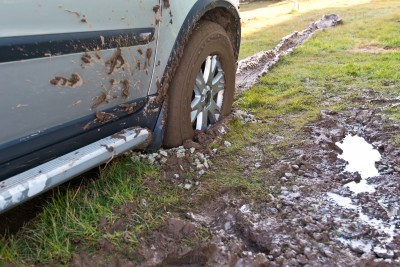
We bring you some top tips on avoiding getting your motorhome stuck in the mud and coping with wet ground.
- Be prepared – Know if your vehicle is front or rear wheel drive so in the need of a muddy escape you know where to start! Of course most motorhomes are front wheel drive in the UK but there are some rear wheel drive models on sale.
- Check the weather. If heavy rain is forecast or there’s been a lot of rain before your trip, it’s probably a good idea to carry some track/grip mats or wheel grippers and wheel ramps, especially if you’re pitching on the grass. And if you can, park your motorhome’s wheels as close to a surfaced road as possible. If you’re on-site for a few days and it’s looking like a rainy stay then you’re motorhome might start out okay but a week on top of soft ground might just end up like a stick in the mud!
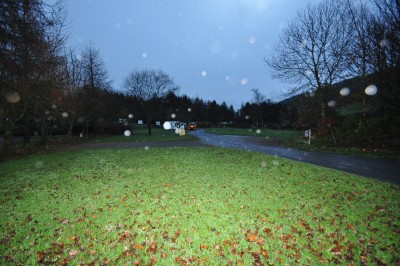
- Check out the access to your pitch. Chances are you’ll have to drive over a grassed area which can become treacherous when wet. Some sites will have matting to help your vehicle grip but if not, take care so the ground doesn’t start to cut up.
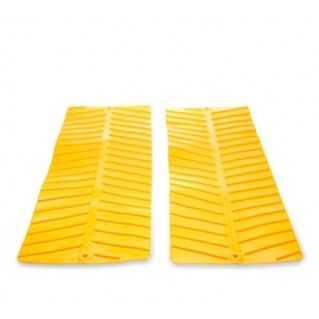
- Set your ramps and track mats in the direction of any road on the campsite so when it’s time to leave you’ll have some momentum for your escape.
- Invest in some mud-busting kit. It might make your stay on a wet and soggy campsite a bit more pleasant if you take some flooring for outside the ‘van and in the entrance area. There are a range of products available, such as plastic or rubber mats, or interlocking floor tiles and rolls of rubber or plastic flooring, which can be used to create walkways to and from your motorhome or inside your awning when the grass is soft and wet.
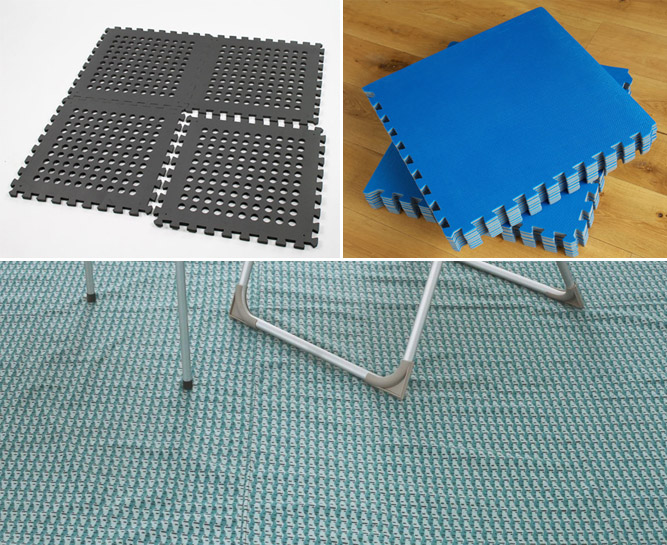
- If you find you’ve got that sinking feeling in a muddy field start by getting the driving wheels on to a track or grip mat or a plank of wood. Interior rubber car mats could also be used to get some traction when stuck in the mud and if you don’t have some specialist track or grip mats on board. We’ve even heard of baking trays or the bottom of bread crates being used to park up on in a muddy field!
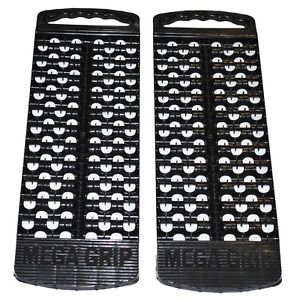
It’s important to keep up any momentum to avoid getting stuck and to be patient. Don’t think you’ll get out of the mud without some kind of traction aid and do be careful not to leave a chewed up camping field. But, don’t be afraid to ask for help on site or call your breakdown recovery service.
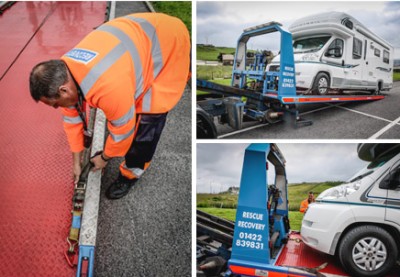
Luckily Caravan Guard’s motorhome breakdown cover, included with our motorhome insurance policy, includes stranded in mud recovery whilst in the UK– helping you get your motorhome to firm ground.
(Benefits are correct at the time of publication and are subject to terms and conditions, cover level and underwriting criteria. Click to read policy wording)
Over to you…
Have you got any advice on not getting your motorhome or campervan stuck in the mud that you’d like to pass on or stories to share? Please feel free to comment below.


When we were stuck in the mud with our A class on a field last year we used our snow chains ….. they were brilliant… cars we’re getting stuck and one even burnt his clutch out .. you should have seen people’s faces when we glided out of the field priceless
Simple advice really.Dont ever park front wheel drive on the slightest slope were the rear wheels are higher than the front.It is easier to run off a slope than reverse up it.
I would add that advice re. tow ropes would be helpful
Re. ‘Stuck in the mud’ article
Thanks for addressing the issue. However:
1. Tyre mats
a. both track and grip types are mentioned with no explanation of the difference
b. no guide to purchasing mats
c. no advisability to park up on mats on arrival
2. Tow points on van: no guide to finding these
3. No advice on how to get out of a sticky position
a. rock back and forth to enable mats to be placed
b. put mats in front of drive wheels
c. keep going until firm ground
4. Note that breakdown rescue will not increase insurance premiums
Thanks for adding in the extra comments.
Stuck in mud in Belgium, in early April. No experience of heavy laden Campervan on soft ground. Week after received your email on being stuck in mud. Brilliant article, and good replies to your article. Is it possible to get cover on caravan guard policy for Europe?
Hi George, I can confirm that if a motorhome is stranded in mud cover in Europe, this is covered under the breakdown aspect of our policy.
Good info we were also at the Peterborough show never seen vans pulled on to a muddy field to start the weekend no wonder they had to be pulled off
Just like to point out we were with RVOC and all the Rv;s got off with out assistance heavier and rear wheel drive I find using a higher gear worked when I owned a European van
Alas for anyone at the National Motorhome Show this weekend this article arrived too late, and it is wise to accept that not even a full range of mats either manufactured or home made would have stopped you getting bogged down at Peterborough.
To Tractor Drivers and Marshall’s we must extend our thanks for their tireless efforts, and to the showground spend some of your profits on 21st. century solutions to badly drained grass sufaces.
Back today from the Peterborough show and managed to get off the boggy site by reversing off motorhome levellers and not stopping until solid ground. Loads of vans being pulled off by tractors.
if you use the yellow grip mats illustrated above tie them to the rear of your Motorhome so they come with you when you drive onto solid ground saves a walk through the mud.
Andy Culley’s advice is spot on. I had experience of this some years ago in West Australia. I’d gone rambling from the beach at Kalbarri and came across an elderly car with two young people in it, stuck in fine sand and sinking further as the driver gunned the engine. Experience of driving Ferret scout cars in snow in the UK some twenty years earlier came the rescue. I got the youngsters to get out of the car, leave the doors open and the engine running, engaged in the highest gear which would still keep the wheels turning. Even so, the sand was too fine and the car itself did not move, but with the three of us pushing from behind we slowly ploughed our way through the sand until the front wheels hit solid ground, at which point the engine stalled – but being now on solid ground, as soon as the engine was restarted the tyres gripped and away they went.
If the ground is slippery LEAVE THE THROTTLE PEDAL ALONE.
Engage first gear, let the clutch up VERY SLOWLY without any throttle at all. Your vehicle WILL move forwards very slowly on tickover, just let it inch forwards until you are on solid ground. Modern vehicles have “anti-stall- software built into the ECU so it will stop your vehicle stalling. Try this technique on solid ground first so you KNOW it works and will have the confidence to use it if you are ever on slippery ground.
Try it, it REALLY works.
Andy
Thanks Andy.
Once we were parked in a sandy beach in Spain and got well trapped. The more i tried the more the front wheels dug in. Luckily I had the plastic mats you mentioned and it was so easy to use. Now I carry these all the time.
I’m glad I opted for Traction + !!!
Very funny that this article arrived this evening as I at the Peterborough show parked in mud.
Every van parked with MCC at Peterborough motorhome show are stuck had to be pulled on and off slip mats are only good for certain conditions best advice carry a good tow rope
Hope you don’t get stuck Shon!
You do not say whether mud recovery results in increased premiums. These could well exceed alternative cost for mud recovery.
It’s one of the features of our UK Breakdown cover, which is automatically included as part of every motorhome policy.
There is no extra premium to pay.
We got stuck on a slightly downward grass pitch about 10ft off the paved road year before last. We had been on/off the pitch every day for the week, then on our last night it rained a fair bit overnight and in the morning I immediately got stuck trying to drive off. I didn’t have grip mats or a tow strap, which was frustrating as we were surrounded by caravanners with 4×4/tow balls. Luckily someone in the next row came over with a tow strap and pulled us straight out. Since then I’ve bought a tow strap and a set of grip mats – total cost was about a tenner. A couple of times since when rain is forecast I’ve parked on the grip mats, and driven off with no problem – I think its just the first foot or so which matters, once you have the van rolling it is fine even on fairly wet grass.
Loved the mud busting kit, think we’ll invest in some of those interlocking tiles.
A really useful article, made me think about boggy fields!
Having owned both front and rear wheel drive motorhomes over the last 25 years, and done it in all weathers throughout the year, I have found that the rear wheel drive is far better in soggy wet slippery conditions and if I found myself in similar conditions in a front wheel drive I would drive it in reverse. This certainly improves traction considerably. Once whilst on a sloping grassy site on the east side of Loch Ness, in a front wheel drive Swift Kon-tiki, when it was absolutely teeming with rain, my first few attempts to reach the higher ground failed miserably, I then tried it in reverse, the result was instant success with no scarring of the site grass. I have used this reverse practice to retrieve a fair sized French motorhome which had sunk into soft sand, made worse when the french man had tried to’power’ his way out. Again I was in a front wheel drive Kon-tiki.
Thanks for sharing this Jim.
Great article, very informative and so helpful.
Thanks for the great feedback Chris.